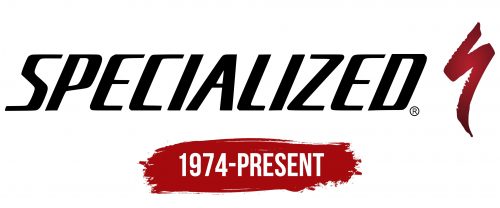The Specialized logo reflects the innovative style of the products released under this brand. As a result, the emblem conveys a high level of dynamism, capturing the energy inherent in this brand’s mountain bikes and other bicycles.
Specialized: Brand overview
Specialized’s origins started in 1974 when Mike Sinyard, an avid cyclist and businessman, established his company in Morgan Hill, California. At first, the business concentrated on importing premium bicycle parts from Europe, especially Italy. After observing a gap in the American market for high-quality bicycle parts, Sinyard decided to close this gap.
Initially, Sinyard traveled to Europe to buy parts and build connections with producers. His meticulous attention to detail and dedication to delivering the best products to American bikers swiftly established the company as a dependable source of the highest caliber of bicycle parts.
1976 was a significant turning point for the business. The superior Touring Tire was the first proprietary product released. This tire gained popularity among cyclists due to its dependability and longevity; it was created especially for long-distance riding.
The first mass-produced mountain bike, the Stumpjumper, was introduced in 1981, completely changing the riding industry. The Stumpjumper is designed for off-road riding and has a robust frame, large tires, and dependable parts. In addition to becoming a best-seller, this bike helped the cycling community enter a new phase by opening up mountain biking to a wider range of people.
The company experienced a remarkable expansion in the 1980s. The business increased its product range by adding frames, parts, and accessories. The Allez, the first road bike, was released in 1985 and immediately became well-liked by amateurs and professional racers.
In 1989, the company introduced the Epic, the first mountain bike made entirely of carbon. This ground-breaking invention made the bike much lighter without sacrificing strength. The Epic demonstrated this technological leadership and commitment to innovation.
Technical developments and product range expansion continued in the 1990s. The Hotrock, the company’s first kid-specific bike, was released in 1991. It was created with the morphology and demands of young riders in mind.
In 1995, the business introduced the FSR (Future Shock Rear), a cutting-edge rear suspension technology for mountain bikes. This innovation created a new benchmark for the industry and significantly enhanced handling and comfort on uneven ground.
Professional racers soon took to the high-tech road bike, the S-Works Road, which debuted in 1999. This bike showed that the company could compete in road cycling at the top level.
Technological advancements and global expansion characterized the company’s 2000s. In 2001, it established its first office in Switzerland, increasing its footprint in the European market.
A new mountain biking category called “enduro” was created in 2003 when the company unveiled the Enduro, a bike that blended downhill and cross-country riding characteristics.
The Turbo, the company’s debut electric bike, was released in 2004. Despite being experimental and not mass-produced, this model served as a foundation for the company’s subsequent development of electric bikes.
Body Geometry is a collection of ergonomic parts and accessories that the business introduced in 2008 to improve comfort and ride efficiency by considering human anatomy.
Product line expansion and ongoing technology advancements defined the 2010s. The Venge, an aerodynamic road bike created in association with McLaren Applied Technologies, was introduced by the business in 2011.
In 2013, a revised version of the Turbo, a complete electric bike that blended impressive performance with a cutting-edge electric powertrain, was unveiled.
The Diverge, a gravel bike that mirrored the rising trend of mixed-surface riding, was released in 2015.
The Venge ViAS Disc, the company’s first aerodynamic road bike with disc brakes, was unveiled in 2016. Combining cutting-edge aerodynamic technology with an upgraded braking system greatly increased this bike’s performance and safety.
The Epic, the newest generation of mountain bikes, was introduced in 2017. This model had the innovative Brain 2.0 suspension system, which was completely overhauled and optimized comfort and pedal efficiency by automatically adjusting to trail conditions.
2018, the firm introduced one of the most sophisticated electric mountain bikes, the Turbo Levo. The Turbo Levo increased riders’ ability in mountainous terrain by combining a potent motor with an advanced control system.
The company unveiled a new range of helmets with MIPS SL technology in 2019. This cutting-edge safety feature was created to lessen the possibility of brain damage from falls, providing cyclists with increased security.
The flagship road bike, the Tarmac SL7, was overhauled in 2020. Combining the greatest features of the previous Tarmac and Venge models, this bike is a flexible option for road cycling enthusiasts and professional racers.
In 2021, the company introduced the Como SL, a new range of electric bikes designed for city riding. These bikes were lightweight, fashionable, and integrated smartphone apps for easy use.
In 2022, the business strongly emphasized sustainability and launched several programs to lessen its environmental impact. These include a program for recycling used bike tires and tubes and using recyclable materials to construct bikes and accessories.
The company unveiled the Stumpjumper, a new mountain bike version, in 2023. This model’s improved suspension and revised frame geometry improved the bike’s handling and efficiency on difficult trails. The brand-new Turbo Tero model, targeted at adventure travelers, increased the company’s selection of electric bikes.
In 2024, the company concentrated on material advancements. It made a big stride toward more environmentally responsible manufacturing when unveiled a prototype bike frame constructed of recycled carbon fiber. Furthermore, the company used 3D printing technology to build personalized saddles and pedals as part of the expansion of its custom component development program for top riders.
Meaning and History
What is Specialized?
The American company designs and manufactures bicycles, cycling equipment, and accessories. It offers a range of products, including road, mountain, and electric bikes, as well as gear such as helmets, shoes, and apparel. The company is known for its quality, and new technologies are constantly being developed to improve the cycling experience. The brand targets professional and amateur athletes, providing the best equipment for various cycling disciplines. It has a strong reputation in the cycling community for performance, durability, and meeting the needs of cyclists.
1974 – today
Since the company targets young and active people who love extreme sports and everything related to them, it chose a logo with an unconventional design. In particular, the following stand out:
- Italic font
- Unusual symbol
- Minimalist form
These elements accurately express the concept of the American two-wheeled transport manufacturer. The slanted text conveys the brand name, the sensation of fast bike riding, and the energy it generates. The font embodies high reliability, maneuverability, lightness, and the unstoppable power of the branded products. Additionally, it symbolizes forward momentum, purposeful movement, magnetism, strength, and innovation. So, it’s not just a name; it’s a significant element reflecting the essence of the bicycle brand and its purpose.
The unique font in a strict style appeals to the target consumer segment – teenagers, athletes, and active youth. They are psychologically inclined to perceive the informal style of the lettering, as the younger generation is drawn to everything new, unconventional, modern, and progressive. This is precisely the type of product the famous bicycle manufacturer offers, reinforcing its position with an atypical font emblem.
As a result, the distinctive symbolism strongly resonates with the target audience, helping the company become one of the top five in the USA. The smooth italic letters with rounded corners evoke the desired response: dynamism, determination, progress, energy, the desire to move forward, and successfully overcome obstacles. They make the logo highly recognizable and fit perfectly on bicycle frames, marking them. This is why the text is stretched horizontally – making it easier to apply to the long, curved frame.
A dark red stripe placed behind the name reinforces the idea of dynamism. It represents a maneuver, a turn, a checkmark, a finish line, and a winding shape. The stripe’s placement is unconventional: it runs vertically, cutting through space from top to bottom. The contrasting palette of black and red adds to the energy. The text is black, and the logo symbol is red. Overall, the Specialized emblem is unique and innovative, just like the bicycles produced by this American manufacturer.






